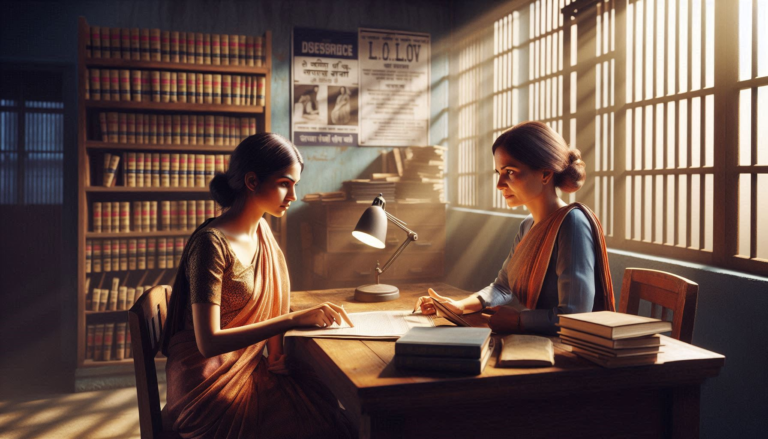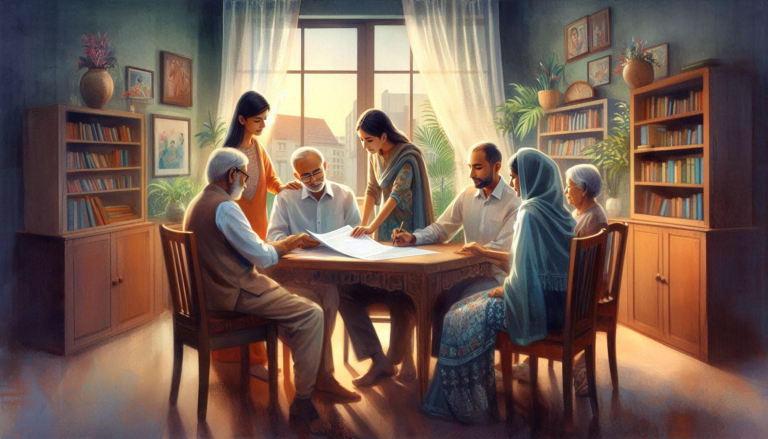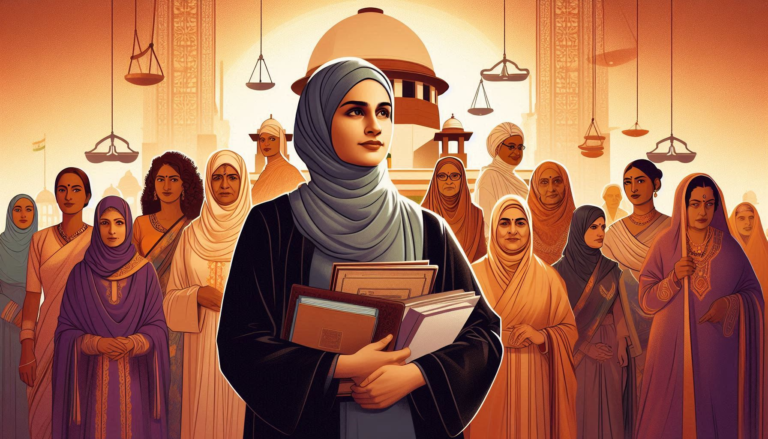
Abstract
Even in the most modern phase of the 21st century, gender equality remains a distant dream, a utopian ideal we’ve long struggled to realise. The fight for gender justice began with the demand of the most fundamental rights: access to education, equal opportunities in the workplace, rights over the shared household, fair property ownership, maintenance rights, and the most basic right of all: being born.
Every day, brave battles are fought against laws that fail to recognise women or treat them as secondary, mere property of men. Personal laws, in particular, paint a fragmented picture, some condemning bigamy as a crime and a ground for divorce, while others permit polygamy, leaving room for inequality. Similarly, where dowry is criminalised, dower remains a woman’s right, creating a rift in women’s rights. The path to true gender equality is riddled with contradictions and hurdles, but the fight continues, driven by hope, resilience, and an unwavering demand for justice.
The prospect of implementing a Uniform Civil Code offers hope for uplifting women and promoting equality. Currently, we face a complicated system of personal laws based on religion, ethnicity, and community. These laws regulate various aspects of individual lives, including marriage, divorce, inheritance, and adoption. The variety of personal laws has often resulted in disparities and inconsistencies, perpetuating inequality and injustice. This article critically analyses whether the rising demand for UCC actually brings gender justice.
Keywords
Uniform Civil Code (UCC), Gender Equality, Gender Justice, Personal Laws in India, Women’s Rights, Constitutional Law, Equality before Law (Article 14), Non-discrimination (Article 15), Secularism and Law, Legal Pluralism.
Introduction
From the period of kings, rulers in India have refrained from interfering with personal laws, recognising them as matters deeply entwined with faith, family, and social order. Personal laws have long governed the most complex and pivotal aspects of human life: marriage, divorce, adoption, maintenance, alimony, inheritance, custody, guardianship, and succession. This pluralistic approach, though respectful of religious diversity, created diverse and uncontrolled systems of justice where rights vary not by gender or citizenship, but by creed.
The inability to codify these personal laws uniformly is rooted in the delicate constitutional balance, the need to preserve India’s secular fabric while avoiding excessive state intrusion into religion. Yet, this restraint has left deep scars on gender justice. Even today, discriminatory practices remain shielded by the scarf of faith: a Parsi woman marrying outside her community may lose her inheritance rights; Muslim women face unequal divorce mechanisms; Hindu widows only recently gained equal coparcenary rights through judicial and legislative intervention. Each instance signifies the ongoing tension between religious autonomy and constitutional equality.
Since time immemorial, Indian women have fought a long and arduous battle to reclaim their rightful place in a male-dominated social order. Ironically, when we call ourselves educated, modern and broad-minded people who still find women under the care of some men around, but in ancient India, women often enjoyed a privileged status, participating in education, philosophy, and property ownership. The Rigveda and various scriptures highlight the presence of scholars like Gargi and Maithali. However, successive waves of religious orthodoxy and colonial intervention eroded and scraped off these freedoms. With the arrival of new religious traditions and rigid personal laws, women gradually turned subordinate. The British colonial regime, while introducing social reforms such as the abolition of sati and the restraint of child marriage, largely retained personal law pluralism to maintain political control and avoid social unrest.
During the framing of the Indian Constitution, the Constituent Assembly debates revisited these contradictions. Many members, most notably Dr B.R. Ambedkar, argued that a Uniform Civil Code (UCC) was essential to ensure equality and eliminate gender and religious discrimination. However, fearing social backlash and in pursuit of secular harmony, the UCC was placed under Part IV (Directive Principles of State Policy), rendering it non-enforceable. Seventy-three years later, that constitutional aspiration remains unrealised.
India’s progress toward gender equality is thus uneven and incomplete. Despite secular laws that criminalise practices such as child marriage, and despite constitutional guarantees of equality under Articles 14 and 15, the lived reality of many Indian women remains defined by discrimination, domestic violence, social stigma, and systemic exclusion. The persistence of such disparities highlights the unfinished business of the Indian Republic: reconciling religious freedom with gender justice.
The debate surrounding the Uniform Civil Code, therefore, demands renewed scrutiny for its jurisprudential hypocrisy. Can a single civil framework genuinely accommodate the deep-rooted diversity of India’s personal laws without diluting either equity or identity? If the UCC enforces uniformity without context, it risks flattening complex systems of rights into a monolithic structure that may serve equality in form but not in substance. The critical question is no longer whether the UCC can unify India’s family laws, but whose values, morals, and hierarchies that “uniformity” will ultimately codify. This paper seeks to interrogate whether the UCC, in its current conception, upholds constitutional equity or merely rebrands majoritarian norms as gender justice, replacing plural injustices with a single, uniform one.
Discussion
The constitutional demand for a Uniform Civil Code under Article 44 has long been interpreted as a call for equality and social justice applicable uniformly. But equality when pursued through sameness can often erase justice rather than ensure it. For instance, for the sake of equality, one cannot expect polygamy to be the accepted norm for all. There is a need for equitable laws that are uniformly applicable.
What India requires is not a uniformity of laws, but a uniformity of rights achieved through contextual equity. Personal laws were not born equal; they were born of diverse religious, moral, and patriarchal constructs which bind them individually and severally. To subject them all to the same legal treatment is like expecting unequal weights to balance on the same scale.
For instance, if uniformity demands that all forms of marriage follow the same standard, what standard will that be?
- Islamic law permits polygamy but criminalises polyandry.
- Hindu and Christian law enforce monogamy, yet both are rooted in patriarchal guardianship over the wife.
If the UCC must choose one, which moral universe prevails and what constitutional justification determines that choice?
A “uniform” approach risks creating majoritarian morality masquerading as gender justice. True reform must equalise rights, not rituals; dignity, not dogma.

The Collision of Personal Law Foundations
Every personal law system rests on an incompatible philosophical foundation:
- Hindu law originates in samskara (sacrament) marriage as a spiritual bond.
- Muslim law views marriage as nikah, a civil contract.
- Christian law sees it as a holy covenant under divine sanction.
- Parsi law enforcers’ communal purity disincentivises interfaith unions.
So, when the UCC claims to “unify” these, the unspoken question is: whose conception of marriage and morality will define the rest? If marriage becomes a civil contract under UCC, it aligns with Muslim jurisprudence but violates the Hindu ideal of sacrament.
If it remains a sacrament, it contradicts Islamic contractarian autonomy.
If the UCC treats marriage as a civil institution independent of religion, it de-religionises personal identity, potentially infringing on Articles 25–26 (freedom of faith and religious practice). This is the foundational tension: uniformity demands a single conception of marriage, divorce, and property, yet no such single conception exists in India’s plural structure.
Property and Succession: Can One Formula Fit All?
Inheritance is perhaps the most sensitive fault line of all.
Under Muslim personal law, a woman is entitled to a specific fractional share (usually one-third), grounded in Quranic injunctions. Under Hindu law, daughters have equal coparcenary rights post-2005. Under Christian and Parsi law, succession follows Western testamentary principles.
Now, if the UCC mandates a uniform rule:
- Should the Muslim woman’s fractional entitlement be replaced by full equality? That enforces constitutional equality but overrides religious law.
- If the fractional model is retained in the name of religious tolerance, that violates Article 14 (equality before law).
Thus, any “uniform” succession rule either sacrifices secularism or violates equality; there’s no middle ground. Uniformity here doesn’t harmonise; it privileges one worldview over another.
Dower, Dowry, and the Paradox of Legal Morality
The UCC’s moral contradictions are unambiguous in economic arrangements surrounding marriage:
- Dowry (Hindu/Christian practice) is criminalised under the Dowry Prohibition Act, 1961.
- Dower (Muslim ‘mahr’) is a legal right of the wife intended as financial security and recognition of her agency.
If the UCC treats both identically under a “uniform” prohibition, it erases the protective intent behind mahr. If it distinguishes between them, it ceases to be “uniform.” So, what moral principle will the UCC uphold, the contractual fairness of Islamic dower, or the abolitionist stance of Hindu-Christian dowry laws? Each path either undermines equality or equity.
This exposes the central flaw in the UCC rhetoric: uniformity without moral clarity breeds injustice disguised as reform.
Divorce, Autonomy, and the Erosion of Choice
The UCC’s supposed “gender-neutral” divorce provisions may create gender blindness, not gender justice. Muslim law recognised multiple forms of separation talaq, khula, mubarat, each reflecting mutual or unilateral rights of dissolution. With instant triple talaq outlawed, what happens to khula, a woman’s right to divorce by returning her dower?
Will the UCC preserve her contractual agency, or erase it under a homogenised model that mirrors the Hindu system’s narrow grounds for divorce? Uniform divorce law, in essence, risks becoming Hindu divorce law in secular clothing, privileging formality over consent, and judicial procedure over personal autonomy.
The Question of Whose Law Prevails
Uniformity, in practice, cannot be neutral. Every “unified” provision borrows more heavily from one legal tradition than another. The Special Marriage Act (1954) already provides a secular model contractual, registration-based, and gender-neutral model. But the UCC’s insistence on replacing rather than offering an alternative turns reform into erasure.
Thus, the fundamental question is not whether we need a UCC, but whose UCC this will be.
- Will it be Hindu-coded uniformity, designed to subsume minority frameworks?
- Or will it be constitutionally coded equity, designed to uplift women across faiths while respecting diversity?
If the former, it perpetuates inequality in the name of uniformity.
If the latter, it requires abandoning “uniformity” altogether and embracing a Code of Equitable Civil Rights, not a Uniform Civil Code.

From Uniformity to Justice: The Reframing India Needs
The obsession with “one law for all” blinds us to the deeper constitutional mandate of one justice for all. The UCC must evolve beyond sameness to contextual parity, intersectional equality, and choice-based uniformity.
Instead of enforcing identical norms, India must:
- Eliminate inequality within personal laws through constitutional conformity.
- Retain choice of personal law but guarantee minimum rights under Article 21 (dignity, autonomy, and privacy).
- Replace coercive uniformity with equitable pluralism where every woman, irrespective of religion, enjoys the same rights, even if through different legal pathways.
Only then will uniformity stop being a political slogan and start becoming a constitutional reality.
Limitations
The current discourse on the UCC, including the Uttarakhand model, reveals deep limitations. It often borrows selectively from existing personal laws without resolving their internal contradictions. The absence of clear provisions on adoption, guardianship, and surrogacy, and the retention of outdated concepts like restitution of conjugal rights, expose the Bill’s fragmented vision. Furthermore, the UCC’s silence on reconciliation between religious autonomy (Articles 25–26) and gender equality (Articles 14–15) underscores a constitutional tension yet to be harmonised. Without reconciling these, the Code risks judicial and social contestation rather than stability.
Suggestions
- Shift from Uniformity to Equity: The focus should move from identical treatment to equitable outcomes. Personal laws may be harmonised through minimum standards of justice, equality in rights, not rituals.
- Harmonisation: Instead of a blanket imposition, reform must proceed sector-wise, starting with marriage, divorce, and inheritance, ensuring community consultation and consensus.
- Codification with Consultation: Minority concerns, especially of women within those minorities, must inform reform. Codification should not become cultural erasure.
- Gender-Responsive Drafting: Replace archaic and patriarchal provisions (like restitution of conjugal rights) with rights-based language focusing on dignity, consent, and autonomy.
- Judicial Oversight and Review: Any UCC must include a review clause ensuring adaptability to evolving constitutional values and social realities.
Conclusion
The Uniform Civil Code stands today at the uneasy intersection of constitutional aspiration and sociological reality. While it invokes gender justice and national unity, the practical and philosophical question remains unanswered: can a single code genuinely capture the plurality of Indian personal laws without erasing their contextual equity? A mere pursuit of equality before the law risks producing a homogenised framework that privileges the dominant over the diverse. The law, in its anxiety to appear uniform, may silence the very women it claims to empower. The real challenge, therefore, lies not in drafting sameness but in crafting fairness. Equity must precede equality. Justice cannot be served by treating the unequal as equal; that would be reform by oversight, not reform by understanding. The promise of a gender-just India cannot be legislated by decree. It must be built through equity, inclusion, and empathy. The UCC, if guided by these principles, could mark a constitutional renaissance, transforming law from a mere instrument of governance into a vehicle of justice. But if drafted in haste, without grounding in equity, it will remain what it has long been: a mirage of equality in the desert of difference.
References
- https://thewire.in/rights/not-in-the-name-of-gender-justice-reflections-on-the-uttarakhands-ucc
- https://www.ijnrd.org/papers/IJNRD2303255.pdf
- https://www.tscld.com/uniform-civil-code-towards-gender-justice




